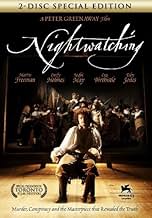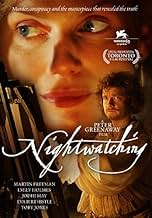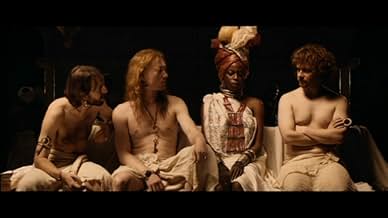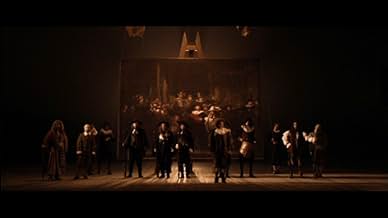CALIFICACIÓN DE IMDb
6.5/10
3.6 k
TU CALIFICACIÓN
Agrega una trama en tu idiomaAn extravagant, exotic and moving look at Rembrandt's romantic and professional life, and the controversy he created by the identification of a murderer in the painting 'The Night Watch'.An extravagant, exotic and moving look at Rembrandt's romantic and professional life, and the controversy he created by the identification of a murderer in the painting 'The Night Watch'.An extravagant, exotic and moving look at Rembrandt's romantic and professional life, and the controversy he created by the identification of a murderer in the painting 'The Night Watch'.
- Premios
- 6 premios ganados y 6 nominaciones en total
Anja Antonowicz
- Catharina
- (as Anna Antonowicz)
- Dirección
- Guionista
- Todo el elenco y el equipo
- Producción, taquilla y más en IMDbPro
Opiniones destacadas
My advice is to first watch 'Rembrandt's J'Accuse', Greenaway's companion film. It fills you in on the background, the characters, the thesis for the conspiracy, and generally sets the scene for 'Nightwatching' itself, which is extremely elaborate and requires a far more prolonged degree of concentration than 99.9% of films being released. Having said that, the film certainly stands alone as a powerful and intelligent piece of cinema that puts forward a contentious and challenging theory about the circumstances surrounding Rembrandt's painting.
Some viewers have pointed out how moving the film is - and indeed it is. But I for one have found ALL of Greenaway's films to be deeply moving. Unlike mainstream directors, he doesn't attempt to tug at the heartstrings, but instead deploys one rich, elegaic, achingly beautiful set piece after another, letting the ideas and associations reach the emotions of the audience. In Greenaway's world, extreme beauty and extreme horror exist cheek-by-jowl - his heroes (more so than his heroines) look for logic and order, and find ultimately chaos and decay - the good go unrewarded, the bad go unpunished - and yet, out of it all, rises a triumphant celebration of life, art, human aspiration, and the possibilities of cinema itself.
If you want a bedtime story about goodies overcoming baddies, look elsewhere. 'Nightwatching', like Greenaway's other work, offers - and demands - much more than that.
Some viewers have pointed out how moving the film is - and indeed it is. But I for one have found ALL of Greenaway's films to be deeply moving. Unlike mainstream directors, he doesn't attempt to tug at the heartstrings, but instead deploys one rich, elegaic, achingly beautiful set piece after another, letting the ideas and associations reach the emotions of the audience. In Greenaway's world, extreme beauty and extreme horror exist cheek-by-jowl - his heroes (more so than his heroines) look for logic and order, and find ultimately chaos and decay - the good go unrewarded, the bad go unpunished - and yet, out of it all, rises a triumphant celebration of life, art, human aspiration, and the possibilities of cinema itself.
If you want a bedtime story about goodies overcoming baddies, look elsewhere. 'Nightwatching', like Greenaway's other work, offers - and demands - much more than that.
Briefly, the plot of Nightwatching is about Rembrandt's uncovering of a conspiracy during his painting of his most famous work the Night Watch. Just as importantly it's about the three loves of his life.
I've tried to review this film in the context of Peter Greenaway's directing career as it's pretty critical to my appreciation. As much an artwork as any film itself, with a director who has had a long career, is how all the artworks come together as a ghost of their creator. The power of women over men is something that Greenaway has always reflected on in his films, and in that context Nightwatching represents a mellowing of his gaze. Always fascinated by women destroying men or cuckolding them in some way, Greenaway has made a film where the central character of the painter Rembrandt lives amongst women, and whilst often bewildering to him, they are companions. There are remnants of the past style at the beginning of the movie where during a family meal all the women in the room chant together, "Contemporary women are permitted to smoke, write, correspond with Descartes, wear spectacles, insult the Pope, and breast-feed babies.". The result here is charming as opposed to alarming. A far cry from "Deadman's Catch" in Drowning By Numbers (1988), a catching game where players are successively handicapped for missing catches, and finally wrapped in a winding sheet (traditionally used for corpses) when they lose. The women escape unscathed, perfect catchers, people that exist in some sort of harmony with life, who can find a place and a rhythm. In Nightwatching women still have that rhythm but they don't end up murdering their husbands! On the other hand Rembrandt does have to defend Hendrikje Stoffels from the advances of the callow and the licentious, and women, though with this rhythm are victims of men rather than succubi.
Another echo is a reference to cuckoldry, when Rembrandt discourses on how Potiphar was a cuckold who, "...slept with young men in order to avoid the temptation of his wife trying to screw Joseph". Apparently the Jewish tradition relating to Potiphar related in the Talmud, is that Potiphar bought Joseph as a catamite. Rembrandt learnt this from a rabbi friend of his, an interesting fact in a very well researched movie.
I've seen many Rembrandt drawings and paintings in museums, but I never knew that he had actually produced a small number of erotic works, which is something that Greenaway draws out in his extremely ribald Rembrandt. A fierce critic of Rembrandt, Andries Pel, who despised Rembrandt's realism, in 1681 wrote of his females nudes, "...the traces of the lacings of the corsets on the stomach, of the garters on the legs must be visible if nature was to get her due.". Rembrandt's fascination with this sort of thing is again picked up on by Greenaway.
When I went to the Rijkmuseum in Amsterdam and stood in front of the Night Watch, I very much felt that the men in the painting were poseurs and dandies and that I had no interest in the painting because of this. That though was precisely Rembrandt's point, and Greenaway really helped to bring the painting and much of his other work alive. Something that Greenaway has said about this film is that Amsterdam for a time in the 1640s was a place of unregulated wealth gathering by a handful of civil dynasties, similar to modern Russia.
I felt that in line with what I'm saying about mellowing and maturity, the choice of composer Giovanni Solamar, who is far less famous than frequent collaborator Michael Nyman, follows along the same trajectory, the music is far less flashy, but somehow full of confusion and elegiac tones, more consistent with a film from an older and wiser filmmaker.
I felt that I could connect with Rembrandt's grief at the death of his wife Saskia, and that there was something quite special about that. Despite the fact that Greenaway manages to build scarce suspense around the uncovering of the treachery that Rembrandt seeks to expose, I think it's a film that I will remember forever, with several, to my mind, iconic scenes. I think it helped immensely in my taking in of the film that Martin Freeman looks so much like Rembrandt, especially with the care and attention the hairdressers heaped upon him, something that's quite critical when you have a man so famous for self-portraiture.
I've tried to review this film in the context of Peter Greenaway's directing career as it's pretty critical to my appreciation. As much an artwork as any film itself, with a director who has had a long career, is how all the artworks come together as a ghost of their creator. The power of women over men is something that Greenaway has always reflected on in his films, and in that context Nightwatching represents a mellowing of his gaze. Always fascinated by women destroying men or cuckolding them in some way, Greenaway has made a film where the central character of the painter Rembrandt lives amongst women, and whilst often bewildering to him, they are companions. There are remnants of the past style at the beginning of the movie where during a family meal all the women in the room chant together, "Contemporary women are permitted to smoke, write, correspond with Descartes, wear spectacles, insult the Pope, and breast-feed babies.". The result here is charming as opposed to alarming. A far cry from "Deadman's Catch" in Drowning By Numbers (1988), a catching game where players are successively handicapped for missing catches, and finally wrapped in a winding sheet (traditionally used for corpses) when they lose. The women escape unscathed, perfect catchers, people that exist in some sort of harmony with life, who can find a place and a rhythm. In Nightwatching women still have that rhythm but they don't end up murdering their husbands! On the other hand Rembrandt does have to defend Hendrikje Stoffels from the advances of the callow and the licentious, and women, though with this rhythm are victims of men rather than succubi.
Another echo is a reference to cuckoldry, when Rembrandt discourses on how Potiphar was a cuckold who, "...slept with young men in order to avoid the temptation of his wife trying to screw Joseph". Apparently the Jewish tradition relating to Potiphar related in the Talmud, is that Potiphar bought Joseph as a catamite. Rembrandt learnt this from a rabbi friend of his, an interesting fact in a very well researched movie.
I've seen many Rembrandt drawings and paintings in museums, but I never knew that he had actually produced a small number of erotic works, which is something that Greenaway draws out in his extremely ribald Rembrandt. A fierce critic of Rembrandt, Andries Pel, who despised Rembrandt's realism, in 1681 wrote of his females nudes, "...the traces of the lacings of the corsets on the stomach, of the garters on the legs must be visible if nature was to get her due.". Rembrandt's fascination with this sort of thing is again picked up on by Greenaway.
When I went to the Rijkmuseum in Amsterdam and stood in front of the Night Watch, I very much felt that the men in the painting were poseurs and dandies and that I had no interest in the painting because of this. That though was precisely Rembrandt's point, and Greenaway really helped to bring the painting and much of his other work alive. Something that Greenaway has said about this film is that Amsterdam for a time in the 1640s was a place of unregulated wealth gathering by a handful of civil dynasties, similar to modern Russia.
I felt that in line with what I'm saying about mellowing and maturity, the choice of composer Giovanni Solamar, who is far less famous than frequent collaborator Michael Nyman, follows along the same trajectory, the music is far less flashy, but somehow full of confusion and elegiac tones, more consistent with a film from an older and wiser filmmaker.
I felt that I could connect with Rembrandt's grief at the death of his wife Saskia, and that there was something quite special about that. Despite the fact that Greenaway manages to build scarce suspense around the uncovering of the treachery that Rembrandt seeks to expose, I think it's a film that I will remember forever, with several, to my mind, iconic scenes. I think it helped immensely in my taking in of the film that Martin Freeman looks so much like Rembrandt, especially with the care and attention the hairdressers heaped upon him, something that's quite critical when you have a man so famous for self-portraiture.
I'm really amazed with the work Peter Greenaway did in this movie. I have seen most of his films and this one is now my favourite. It's impressive the way the made every frame a moving Rembrandt's painting. This is pure art cinema. The story is told in a creative way, you can understand the clever mind of Rembrandt, follow his steps in his life focused on his most famous painting "The Night Watch", it could be a "slow" movie but the way "Rembrandt" tells the story makes it smooth; dramatic, funny, and smart. I could frame this movie on a museum. The "Holland" world is perfectly shown, the costume design is superb; every single detail in the movie takes you to 1642. To appreciate this movie you must know who Peter Greenaway is and understand why "cinema" is the 7th art.
In my old Balkan country, we used to have a wise saying warning against bothering with a huge sack to collect fruit from a famous fruit tree. This applies almost perfectly to the last Peter Greenway's Anglo-Polish-Dutch super production, around the creation of NIGHT WATCH, one of the most famous paintings in the world. Assassination attempts were performed against this masterpiece, resulting in its sheltering behind a thick glass in the Rijk Museum, and the same shelter may be used against this strange assembly of four-letter words, (predominant in modern movies), naked bodies sometimes sculptural, sometimes dull, and a certain research in the lighting; after almost 150 minutes of sometimes boring, sometimes nonsensical dialogues, the viewer hits home with the impression that his money was stolen. Only two movie theaters adventured to expose this failure (in my eyes, but the audience was heavy and very receptive), at my 4 pm show, in the exclusive artistic district of Saint-Germain des Près.A real waste of talent and efforts. I am not ready to view another Peter Greenway movie.Harry Carasso, Paris, France
This film, which I saw yesterday at a single, sparsely attended 4:00 p.m. show, part of an AFI European film festival, may thrill Greenaway fans, but a broad cross-section of movie lovers will probably find it mannered and dull. Shot Rembrandt-style, it apparently aspires to be an homage to art, to the 17th century artist, and to his early-modern eye for humanity -- the cinematographer keeps coming back to, and lingering over, eye shots -- combined with a detective story, a psychodrama, a domestic drama, a costume drama, a self-conscious allusion to the director's earlier dramas, and a brawling, lusty slice of Low Country life in the era when kings waged war with parliaments, city walls were just starting to come down, and commerce was beginning to muscle aside the gun as the engine of empires.
The film badly needs editing. Everything that happens when a camera is turned on is not necessarily art or even interesting. The 144 minutes I saw would have benefited had they been shrunk by nearly an hour. First kill all of the improvised scenes. Then kill all of the gratuitous sex scenes and needless expletives. Then kill all of the scenes in which an actor talks directly to the audience. Then kill all of the precious, mannered references to other Greenaway films -- statues played by semi-nude actors, sides of beef hung out to dry, etc. etc. Tighten up the detective story. Lighten up the art analysis. Minimize the posing scenes. Voila. You'd be at 90 minutes without any problem.
Not for the uncommitted or the faint of heart.
The film badly needs editing. Everything that happens when a camera is turned on is not necessarily art or even interesting. The 144 minutes I saw would have benefited had they been shrunk by nearly an hour. First kill all of the improvised scenes. Then kill all of the gratuitous sex scenes and needless expletives. Then kill all of the scenes in which an actor talks directly to the audience. Then kill all of the precious, mannered references to other Greenaway films -- statues played by semi-nude actors, sides of beef hung out to dry, etc. etc. Tighten up the detective story. Lighten up the art analysis. Minimize the posing scenes. Voila. You'd be at 90 minutes without any problem.
Not for the uncommitted or the faint of heart.
¿Sabías que…?
- TriviaDirector Peter Greenaway has said of this film: "The 'painter film' is a small genre of its own: Michelangelo, Rembrandt himself (at least twice), Modigliani, Caravaggio, etc, and none more so than just lately. Picasso, Van Gogh (repeatedly), Bacon, Vermeer, and now Goya have received the treatment. I suppose our major aim in the film Nightwatching, apart from trying to match the Master's mastery of light, is to demonstrate Rembrandt as social moralist: it contains a murder mystery - the unraveling of which is the heart of the film. And also to regard Rembrandt as an inventor of cinema before the Lumière brothers...We tried to rise to the challenge in the film, remaking, with high definition digital tape, that upper right-hand corner space of Velázquez's Las Meninas - the area between the walls and ceiling has been described as the greatest bit of painting ever - a painting which is just and only and magnificently a painting of a block of darkly contrasting air. We, too, attempting a grand response Rembrandt image of light, tried to film a block of air that insubstantially floats, irrespective of walls and ceiling. Godard said that the cinema was the truth 24 frames a second. Can painting go better and say that paintings are the truth for all time? What's a second in cinema time if you can have an eternity in painting time? Cinema has come and gone in 112 years. What, then, is the age of painting?".
- ErroresAt 1:36:42 Rembrandt says that Geertje doesn't wash herself. Just 1 minute later he says he saw her undressing to wash.
- Citas
Titia Uylenburgh: Women in the 17th century are allowed to smoke, write, correspond with Descartes, wear spectacles, insult the Pope, and breast-feed babies.
- ConexionesFeatured in Rembrandt's J'Accuse...! (2008)
Selecciones populares
Inicia sesión para calificar y agrega a la lista de videos para obtener recomendaciones personalizadas
- How long is Nightwatching?Con tecnología de Alexa
Detalles
- Fecha de lanzamiento
- Países de origen
- Sitios oficiales
- Idioma
- También se conoce como
- Nightwatching
- Locaciones de filmación
- Productoras
- Ver más créditos de la compañía en IMDbPro
Taquilla
- Presupuesto
- USD 7,500,000 (estimado)
- Total a nivel mundial
- USD 698,544
- Tiempo de ejecución2 horas 14 minutos
- Color
- Mezcla de sonido
- Relación de aspecto
- 2.35 : 1
Contribuir a esta página
Sugiere una edición o agrega el contenido que falta

Principales brechas de datos
By what name was La ronda de noche (2007) officially released in Canada in English?
Responda
































